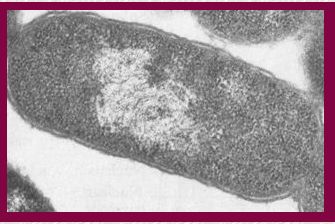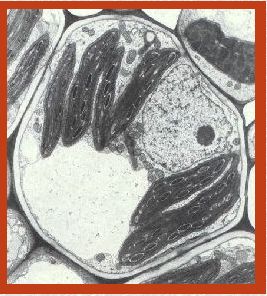 Lesson 2:
Lesson 2:
 Earth
Earth
 Planet of Life
Planet of Life
|
 2.9
2.9
 History of the Earth
History of the Earth

|
 |
Figure 2.9.1
 Microscopic view of a zircon crystal
Microscopic view of a zircon crystal
determined to be the oldest known terrestrial material.
It is 4.4 billion years old. Chemical analysis suggests
that the Earth was cool enough to have liquid water,
and, possibly, life much earlier than previously thought.
|
From the point of view of Life on Earth, the surprising thing is that
some of the oldest rocks found already have traces of living organisms
(as chemical fossils), from a time shortly after the heavy bombardment
of our planet ceased (around 3.8 billion years ago, the end of the
"Hadean" eon). What this means is that Life arose in the earliest part
of Earth's history, even as the planet was still growing by accretion.
Thus, some 4 billion years ago, Earth must have been cool enough to
allow living organisms to persist. Indeed, the stratification in
sedimentary rocks 3.8 billion years old demonstrates the presence of
large bodies of water. Of course, there had not been enough time yet to
make continental crust, so there would not have been continents and
ocean basins between them. Instead, there were large circular impact
basins, like the mare (pronounced mah-ray) on the face of the Moon, but
filled with water.

|
 |
Figure 2.9.2
 Lunar Mare Humorum. Mare are relics of the
Lunar Mare Humorum. Mare are relics of the
period of heavy bombardment in the early solar system.
They were produced by the impacts of meteorites and
asteroids.
|
The lunar "mare" include the oldest landforms around, going back some 3
billion years. They are dry, despite their watery name. On Earth, such
ancient features could not persist, because of mantle convection (there
is evidence that mountain-building processes started even before 2.5
billion years ago, in the "Archean" eon) and because of erosion (through
chemical weathering and running water). The Earth's face is young,
because it changes all the time. In the memory systems of the ocean
basins (the stacks of sediment at the bottom of the sea) we find nothing
older than 180 million years, a time that represents less than 5 percent
of the age of the oldest rocks found in the continents. So, most of what
we know about the Earth's history comes from the record within the
continents. The quality of that record is not particularly good.

|
 |
Figure 2.9.3
 Colorado River meanders through the
Colorado River meanders through the
Vishnu Schist at the bottom of the Grand Canyon.
These are the oldest exposed rocks on the Earth,
having formed during the Proterozoic period 1.6
billion years ago.
|
In some places, the continental record has a great semblance of order,
as in the stacks of layers visible in the Grand Canyon. However,
invariably there are problems. At the bottom of the Canyon, for example,
we find the "Vishnu Schist", ancient sediments that have been worked
over and heated deep within the Earth, and have thereby lost much of
their memory. The layers are not horizontal but show a steep angle,
reflecting tectonic movement. This is only a mile down into the crust.
If we were to drill deeper, we would find rocks that are ever more
severely disturbed and have lost much of their memory. On top of the
Vishnu Schist (which is Precambrian in age) there is a well-layered
sequence of Paleozoic rocks, and we might expect to read the history of
that time span from them with ease. However, the history is only
incompletely represented. During large parts of the time span
represented by the stack there was no deposition, or there was erosion.
Or else the sediments are poor in fossils, so we can learn very little
about Life during that time, in that place.
What we do know about Earth's history, then, is owed to the assembly of
bits and pieces of evidence from all over. The further back we go, the
hazier the view of what the world was like.
The Precambrian portion of Earth's history (in the Grand Canyon,
whatever lies below the stack of layered rocks) takes up the first 4
billion years of history, about six parts out of seven. The last one
seventh of geologic history is well represented by the fossil record; it
is called the "Phanerozoic" (meaning "animals are apparent", in Greek).
The earlier six seventh are divided into the "Hadean" (time of
bombardment), the "Archean" (3.8 to 2.7 Ga) and the "Proterozoic" (2.7
to 0.6 Ga).
Life in the Archean was entirely dominated by procaryotic forms, that
is, organisms with genetic material distributed throughout the cell.
These were the archea and bacteria. Procaryotes began to make rocks in
grand style in the Archean, with "banded iron formations." These are
finely laminated deposits with alternating layers of iron oxides and
quartz. It is thought that the iron was precipitated out of solution by
photosynthesizing bacteria that produced oxygen during seasonal
blooming. The point is that oxygen was normally absent, which allowed
the dissolved iron content to reach high values. The quartz, presumably,
originated from layers of opal (also precipitated with the help of
organisms). Another type of layered rocks made with the help of
cyanobacteria and found in Archean rocks, is represented by the
"stromatolites", small bacterial reefs built by precipitation of
carbonate in shallow water and by trapping mud within a bacterial film
covering mounds rising from the sea floor.

|
 |
Figure 2.9.4
 A cell of Escherichia coli. E.coli is a
A cell of Escherichia coli. E.coli is a
prokaryote. Its cells have no nucleus. The light-
colored mass at the center of the cell is the DNA.
Prokaryotes are believed to be the first type of
cells to have evolved on the Earth.
|
After some 2 billion years of evolution of bacteria and archea, we find
a rich assemblage of highly diversified procaryotes within the cherts of
the Gunflint Iron Formation.

|
 |
Figure 2.9.5
 Gunflint Chert Fossils from the Canadian Shield,
Gunflint Chert Fossils from the Canadian Shield,
the remains of bacteria that lived 2 billion years ago. These
are the oldest fossils of microorganisms yet found. In addition
to their age, they are remarkable for the diversity of organisms
present.
|
The stage was set for
the evolution of eucaryotes, organisms with genetic materials
concentrated in a single nucleus. The eucaryotic cells differ from their
procaryotic ancestors in having a number of internal structures called
organelles. Apparently at least some of these organelles were acquired
by a kind of contract with different procaryotes (a suggestion put
forward by the American biologist Lynn Margulis). If so, the eucaryotic
cell is the outgrowth of symbiosis, a compound organism to which two or
more procaryote cells have contributed. Passing on the genetic
information from such a complicated structure necessitated major
innovations in the process of cell replication. Thus, the invention of
the eucaryotic cell was one of the largest steps in the evolution of
Life on Earth.

|
 |
Figure 2.9.6
 A corn cell. Corn is a eukaryote. The nucleus
A corn cell. Corn is a eukaryote. The nucleus
is the large circle at the right. This is where the cell's
genetic material is located.
|
After that, it took another billion years to make multi-celled organisms
such as primitive types of coral, then trilobites and molluscs and
vertebrates. Rock-building organisms proliferated and made limestone and
chert. Thus, the continental crust everywhere bears the imprint of life
processes.
The path from fish to people is rather short, compared with all the
major innovations that preceded this development in the last 0.4 Ga.
Some fishes used part of their guts to breathe with, so they could
survive out of water, some learned to walk and to bear young on land.
From there to reptiles, birds and mammals took up the last six percent
or so of Earth history. Intelligent life (depending on one's definition)
starts perhaps 150 million years ago (if we are to believe the scenes in
Spielberg's Jurassic Park): the last three percent of Earth history.
People exist for about one percent of that time (depending on what one
accepts as "people"). Thoroughly modern people, indistinguishable from
our species, exist for the last 60,000 years: one eighty thousandth of
Earth's history. Such is the abyss of geologic time.
|





















